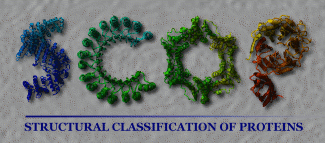




Welcome to SCOP: Structural Classification of
Proteins.
1.75 release (June 2009)
38221 PDB Entries. 1 Literature Reference.
110800 Domains.
(excluding nucleic acids and theoretical models).
Folds, superfamilies, and families statistics
here.
New folds
superfamilies
families.
List of obsolete entries and their replacements.
Authors. Alexey G. Murzin,
John-Marc Chandonia,
Antonina Andreeva,
Dave Howorth,
Loredana Lo Conte,
Bartlett G. Ailey,
Steven E. Brenner,
Tim J. P. Hubbard, and Cyrus Chothia.
scop@mrc-lmb.cam.ac.uk
Reference:
Murzin A. G., Brenner S. E., Hubbard T., Chothia C. (1995).
SCOP: a structural classification
of proteins database for the investigation of sequences and
structures. J. Mol. Biol. 247, 536-540. [PDF]
Recent changes are described in: Lo Conte L., Brenner S. E., Hubbard T.J.P., Chothia C., Murzin A. (2002). SCOP database in 2002: refinements accommodate
structural genomics. Nucl. Acid Res. 30(1), 264-267. [PDF],
Andreeva A., Howorth D., Brenner S.E., Hubbard T.J.P., Chothia C.,
Murzin A.G. (2004). SCOP database in 2004: refinements integrate structure
and sequence family data.
Nucl. Acid Res. 32:D226-D229. [PDF], and
Andreeva A., Howorth D., Chandonia J.-M., Brenner S.E., Hubbard T.J.P.,
Chothia C., Murzin A.G. (2007). Data growth and its impact on the
SCOP database: new developments.
Nucl. Acid Res. advance access, doi:10.1093/nar/gkm993.
[PDF].
SCOP mirrors around the world may speed your access.
Nearly all proteins have structural similarities with other proteins and, in some of these cases, share a common evolutionary origin. The SCOP database, created by manual inspection and abetted by a battery of automated methods, aims to provide a detailed and comprehensive description of the structural and evolutionary relationships between all proteins whose structure is known. As such, it provides a broad survey of all known protein folds, detailed information about the close relatives of any particular protein, and a framework for future research and classification.
A more detailed description of the database is available. Help on using the database may be obtained on any screen by pressing the question mark button.
|
|
Copyright
© 1994-2009 The scop authors /
scop@mrc-lmb.cam.ac.uk (MRC-CPE, MRC-LMB). June 2009 |